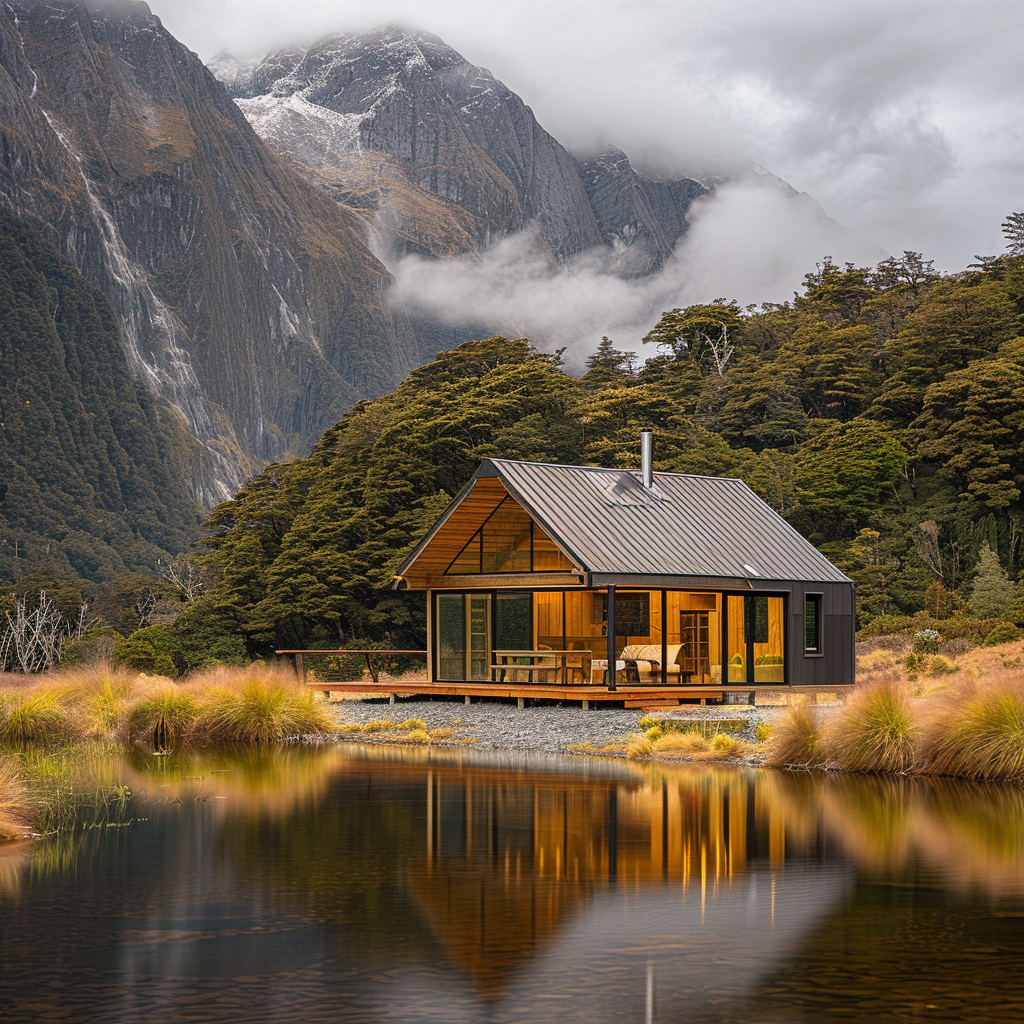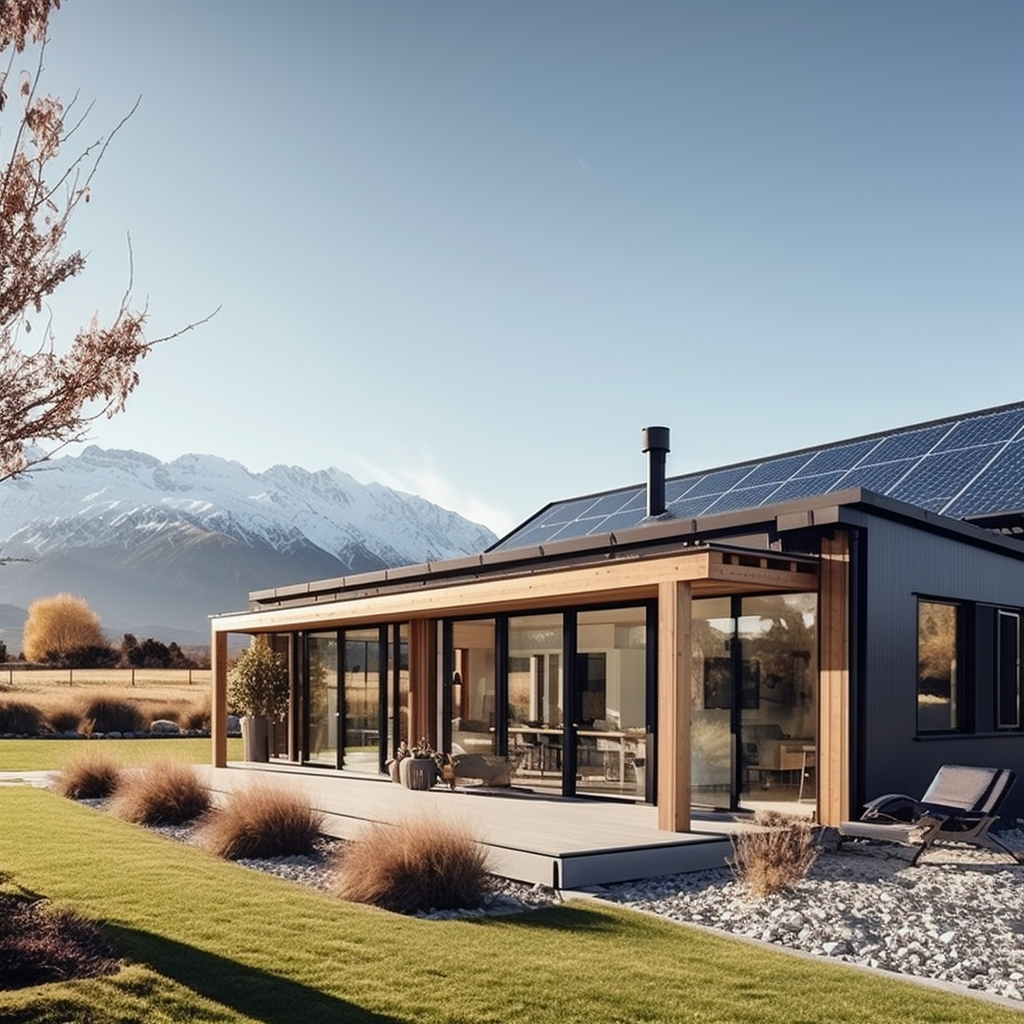Relocatable homes in New Zealand offer a flexible and often more affordable housing solution that caters to a range of lifestyles and needs. These structures, also known as transportable or movable homes, are built off-site and transported to their final destination. They come in various shapes and sizes, from compact one-bedroom abodes to spacious family dwellings.
The appeal of relocatable homes lies in their versatility – they can be placed on almost any site with the right conditions and are designed to be moved again if necessary. This flexibility makes them an attractive option for those who own land and wish to avoid the lengthy process of a traditional build, or for individuals looking to establish a dwelling on family land temporarily.
Selecting the right relocatable home is not just about the aesthetics or the immediate functionality; it's a process that involves several critical steps:
- Assessing personal requirements regarding size, layout, and features
- Setting a realistic budget that encompasses all associated costs
- Deciding between purchasing a pre-loved home versus ordering a new custom build
- Sourcing from reputable suppliers to ensure quality and compliance with building codes
- Evaluating the suitability of the intended site for a relocatable home
- Understanding and navigating NZ council consents for homes
Each step requires attention to detail and an understanding of both short-term needs and long-term implications.
For those planning utilities for relocatable homes, early coordination with service providers is essential. Whether considering on-grid electricity or exploring sustainable off-grid solutions, planning ahead ensures that once the home is in place, it will have all necessary amenities connected without delay.
This guide unfolds each step of selecting and setting up a relocatable home in New Zealand:
- Determine Your Home Needs and Preferences: Dive into how to define your living space requirements and match them with your lifestyle.
- Set a Realistic Budget: Uncover the true cost of owning a relocatable home beyond the sticker price.
- Choose Between a Used or New Build Relocatable Home: Weigh the benefits of pre-loved charm against bespoke modernity.
- Research Reputable Suppliers: Discover how to find suppliers that meet stringent quality standards.
- Assess Site Suitability: Learn what makes a site perfect for your relocatable home.
- Navigate the Council Consent Process: Get familiar with regulatory requirements specific to relocatable homes.
- Make Your Purchase and Consider Customisation Options: Find out how to put your personal touch on your new home responsibly.
- Plan for Utilities and Services: Plan effectively for essential services like water, electricity, and sewage.
By meticulously planning each stage of the journey and obtaining necessary consents, you can set yourself up for success with your new relocatable home in New Zealand.
1. Determine Your Home Needs and Preferences
Embarking on the journey of selecting a relocatable home in New Zealand begins with a critical step: pinpointing your Size and Layout Requirements. The size of your future home affects not only the cost but also the level of comfort and functionality you'll enjoy. It's essential to consider how much space you'll need based on your daily activities, future plans, and the number of inhabitants. Do you envision a cozy two-bedroom cottage or a more spacious four-bedroom dwelling with ample room for guests?
The layout is equally important, as it dictates the flow of your home life. An open-plan living area might suit those who love to entertain, while separate rooms may be preferred for increased privacy or work-from-home setups.
Foundation Requirements for Relocatable Houses
Foundation types vary depending on the relocatable house design and the site conditions. You have options such as concrete slabs, piles, or timber floors — each with its own set of implications for durability, cost, and suitability to ground conditions. Selecting the correct foundation is vital for ensuring the longevity and stability of your home.
Bedrooms, Bathrooms, and Special Features
When considering bedrooms and bathrooms, reflect on:
- Current family size
- Potential growth through new members or frequent visitors
- The necessity for an office space or creative room
- Accessibility requirements for those with limited mobility
- The desire for ensuite facilities or walk-in wardrobes
Special features can significantly enhance your living experience:
- Consider eco-friendly additions like solar panels or rainwater harvesting systems.
- Think about outdoor spaces such as decks or conservatories.
- Assess the need for additional storage areas or garages.
Choosing the Right Relocatable Home
Once you've established your size and layout preferences, it's time to consider whether a used relocatable home could meet your needs or if opting for a new build is preferable. Inspecting pre-loved homes requires a keen eye to evaluate their condition:
- Check for signs of wear: Look out for any damage that might not be obvious at first glance, such as water stains indicating leaks.
- Assess structural integrity: Examine underfloor spaces and roofing for soundness.
- Enquire about modifications: Previous alterations may affect the home’s structure; it’s crucial to understand what changes have been made.
- Evaluate maintenance history: A well-maintained home is likely to present fewer issues down the line.
Inspecting a relocatable home isn't just about what meets the eye; it's also about considering how well it can be adapted to suit your plot of land and whether it aligns with current building codes.
By methodically defining your needs in terms of size, layout, foundation type, bedrooms, bathrooms, and special features, you craft a clear vision of your ideal relocatable home. With this clarity comes greater ease when engaging in discussions with suppliers and contractors — ensuring every choice made is one step closer to realizing your dream living space in New Zealand.
2. Set a Realistic Budget
When you're selecting and setting up your relocatable home in New Zealand, it's crucial to have an accurate Overall Cost Estimation for a successful project. Your budget should cover all expenses, not just the initial purchase price. You need to think ahead and plan for the complete lifecycle of establishing your home.
Initial Purchase and Hidden Extras
The asking price of the relocatable home is a big part of your budget, but it's not the whole story. There are other financial considerations that are easy to overlook:
- Renovation Considerations for Relocatable Homes: If you choose a pre-owned structure, you might need to make changes to suit your preferences or meet current building codes.
- Transportation Expenses: The cost of moving the home can vary depending on how far it needs to go, how accessible the site is, and how big the home is.
- Site Preparation Work: This includes getting the site ready, building foundations, and possibly making changes to the land so the new structure fits.
Breaking Down Additional Costs
To help you understand and plan for these extra expenses, here's a breakdown of common costs that come with relocating a home:
- Renovations and Repairs: Making cosmetic updates like painting or flooring
- Doing structural repairs if a building inspection uncovers any issues
- Upgrading electrical or plumbing systems to meet current standards
- Foundations and Site Work: Doing earthworks to level and stabilise the ground
- Building foundations that are tailored to your relocatable home's specifications
- Installing any necessary drainage systems
- Council Fees and Legalities: Paying fees for building consent
- Getting resource consent if needed, especially in areas with environmental restrictions
- Utility Connections: Covering the costs of connecting electricity, water, and sewage or installing alternative systems like septic tanks
- Landscaping: Doing basic landscaping after the installation or going for more extensive designs
Aligning Budget with Reality
To make sure you stay on top of your finances throughout this process, here are some tips:
- Get Quotes Early: Reach out to professionals in advance so you have a clear idea of potential expenses.
- Set Aside Extra Money: It's a good idea to allocate an additional 10-20% of your total budget for unexpected costs that come up during the move and setup.
- Decide What Matters Most: Figure out which things are essential to do right away and what can wait or be upgraded later on.
- Keep an Eye on Spending: Track all your costs as they come up; this will help you stick to your budget.
By understanding and planning for these expenses from the beginning, you can avoid any financial surprises that might put your housing plans at risk.
3. Choose Between a Used or New Build Relocatable Home
When deciding on a relocatable home in New Zealand, you'll come across two options: buying a used home or constructing a brand new one. Each choice has its own advantages, suited for different preferences and situations.
Benefits of Used Relocatable Homes
Used relocatable homes are perfect for those who value affordability and quick availability. Here's why they stand out:
- Cost Savings: Generally more budget-friendly, used homes allow for significant savings, especially when compared to the price tag of building from scratch.
- Quicker Installation: With pre-existing structures, these homes are often ready for immediate relocation and can reduce waiting times dramatically.
- Character and Uniqueness: A previously loved home can offer distinctive architectural features that lend a unique character not always found in new constructions.
- Reduced Material Waste: Opting for a used home is an eco-conscious choice, repurposing existing materials and reducing the demand for new resources.
Potential buyers should be thorough when inspecting used homes, checking for any structural issues and factoring in possible renovation expenses.
Benefits of New Build Relocatable Homes
On the other hand, new builds allow you to create a home that perfectly fits your vision. Here are the advantages:
- Customisation: Buyers have the freedom to design their dream home, selecting everything from floor plans to finishes.
- Modern Materials: Utilising the latest technologies in construction materials can result in greater energy efficiency and sustainability.
- Warranties and Peace of Mind: New builds often come with warranties that provide assurance against construction defects.
- Long-Term Savings: Although the upfront cost may be higher, energy-efficient designs and modern materials can lead to savings on utilities over time.
Investing in a new build also means starting fresh with no wear and tear, which is appealing for those looking for a long-term housing solution.
Both options have their merits; finding the right balance between immediate needs and long-term goals will help you make the best decision. Whether you're drawn to the unique charm of a used home or the personalised appeal of a new build, each offers its own path to creating your ideal living space.
4. Research Reputable Suppliers
When you're looking for a relocatable home, it's important to work with suppliers who are experienced and follow New Zealand building regulations. This step is about making sure that your future home will be safe, durable, and a good investment.
Trustworthy Supply Sources
Choosing the right supplier means paying attention to their reputation in the market. Here are some strategies to start with:
- Check References and Past Projects: A trustworthy supplier should have no problem providing references. Talking to previous clients can give you insight into how satisfied they were and if there were any issues.
- Review Building Certifications: Suppliers need to follow the New Zealand Building Code. You can check if they have current Licenced Building Practitioner (LBP) credentials or similar certifications.
- Tour Display Homes or Completed Projects: Visiting display homes or completed projects can give you a firsthand look at the quality of construction and finishes.
Evaluating Used House Yards
Used House Yards offer relocatable homes with character and history, often at more competitive prices compared to new builds. Here’s what to consider:
Structural Integrity: It's important to assess the home's structural condition. You should hire a professional building inspector to thoroughly evaluate the building before making any commitments.
Maintenance Records: Ask about past maintenance work and renovations. Having a well-documented history can indicate that the home has been well taken care of.
Compliance Updates: Older homes may require upgrades to meet current standards. Discuss this with the supplier to understand any potential additional costs.
Selecting Relocatable Home Builders in NZ
If you prefer starting fresh with a new build, here are some things to think about:
Customisation Process: Find out how each builder handles customisation. Can they adjust floor plans to fit your needs? Are they flexible with material choices?
Energy Efficiency Standards: New constructions allow for the integration of modern energy-saving features. Inquire about builders' practices regarding insulation, glazing, and energy-efficient fixtures.
Warranties and Guarantees: Get clarity on what warranties are included. Having comprehensive coverage can protect you from future defects or issues.
The Importance of Due Diligence
Doing thorough research is crucial; it's the foundation of your decision-making process. Make use of online resources:
- Online Reviews and Forums: Online communities can provide valuable feedback on suppliers' reputations.
- Professional Associations: Membership in associations like the Registered Master Builders Association shows a commitment to excellence.
- Company Track Record: Look into how long the company has been in business—a longer track record might mean stability and experience.
By taking these steps, you'll be able to make an informed choice about which supplier is best suited to bring your relocatable home dream to life. Remember, this decision sets the stage for the quality of your future home—so take your time and choose wisely.
5. Assess Site Suitability
Choosing the right location for your relocatable home requires a combination of practicality and foresight. You need to make sure that the land is suitable for your new home both structurally and functionally. Here's a step-by-step guide on how to assess a potential site thoroughly:
Initial Site Inspection
Accessibility: Start by checking if the site is easily accessible for transporting the home and living comfortably afterward. Make sure that the roads leading to the site can handle large vehicles needed for transportation, and look out for any potential obstacles like narrow bridges or tight turns.
Drainage: Proper drainage is crucial to prevent water buildup that could cause dampness or even damage the structure over time. Take a close look at the land's natural slopes; they should be sufficient to direct water away from where the home will be placed.
Geotechnical Assessment
Getting professional geotechnical services is highly recommended, especially in New Zealand where certain areas are prone to geohazards.
- Soil Stability: A geotechnical engineer will examine the soil composition and stability, which are vital factors in ensuring a strong foundation. They will determine whether the ground can support the weight of your home without settling or shifting excessively.
- Seismic Considerations: In earthquake-prone zones, it's important to understand how seismic activity could impact your land and what precautions can be taken to reduce risks.
- Flood Risks: The assessment should also identify any flood-prone areas or past instances of flooding, as this information may affect not only the type of foundation you need but also your insurance coverage.
Professional Consultations
Seeking guidance from experts who are familiar with local regulations can help you navigate through potential challenges:
- Council Guidance: Consult with local council experts who can provide valuable information about zoning rules that might influence where and how you can place your home.
- Environmental Impact: Certain sites may have restrictions based on their ecological significance or historical importance, which could impact your options for positioning the relocatable home.
Considering Your Lifestyle
Think about how well the characteristics of the site align with your lifestyle preferences. Here are a few aspects to consider:
- Is there enough space for outdoor living areas or gardens?
- Can you maintain privacy while still following boundary requirements?
Taking these factors into consideration will help ensure that your chosen site not only meets all the necessary regulations but also suits your personal vision for a comfortable living space.
Remember, conducting a thorough assessment of site suitability is an essential first step in your journey towards owning a relocatable home. Once you've completed this stage, you'll be better prepared to handle the complexities of dealing with council permits and consents.
6. Navigate the Council Consent Process
As you start your journey to own a relocatable home, it's crucial to understand the legal requirements involved. One of these requirements is getting Building Consents for Relocatable Homes. These consents are official approvals from your local council, confirming that your planned project meets the standards set by the New Zealand Building Code.
Understanding Building Consents for Relocatable Homes
When it comes to relocatable homes, getting building consent means submitting detailed plans of your home and site to the local council. These plans should clearly show:
- The design and specifications of your relocatable house including size, layout, and structural details.
- Site plan indicating where you intend to place your home on the land.
- Foundation details specifying how you plan to secure your home to the ground.
Remember, building consents are more than just a bureaucratic requirement. They ensure that your home will be safe, healthy, and durable for years to come.
Exploring Resource Consents for Relocatable Structures
In addition to building consents, there might be cases where you need to apply for Resource Consents for Relocatable Structures. Resource consents focus on managing environmental impacts and are usually required if your proposed site has specific features or limitations.
Here are some situations that might call for a resource consent:
- If your property is located in an area identified as having significant natural values (e.g., coastal areas, wetlands, areas of native vegetation).
- If there are heritage buildings or sites on or near your property.
- If your proposed development exceeds certain size or height restrictions outlined in local planning rules.
Tips for Navigating the Consent Process
To navigate these processes efficiently:
- Familiarise yourself with local council rules: Be aware of the specific regulations in your area regarding building and resource consents for relocatable homes.
- Engage professionals when needed: Surveyors, architects, and planning consultants can help make sense of complex regulations and streamline consent applications.
- Start early: The consent process can take weeks or even months, so it's essential to factor this into your project timeline.
Navigating the council consent process may seem daunting, but with a clear understanding of the requirements and careful planning, you can ensure your relocatable home project moves forward smoothly.
7. Make Your Purchase and Consider Customisation Options
Choosing a relocatable home is a practical and personal decision. After going through the earlier steps of figuring out your needs, setting a budget, and assessing the suitability of your site, finalizing the purchase of a relocatable home is a crucial moment that brings you closer to your dream of owning a home.
Finalizing Your Decision
Before signing any documents, make sure to review everything carefully. Here are some important things to look out for:
- Purchase Agreement: Read through the contract to understand what exactly is included in the sale and if there are any warranties or guarantees.
- Title Search: Double-check that there are no outstanding debts or legal issues attached to the property.
- Condition Report: If you're buying a used unit, take a look at any reports that provide information about its condition.
It's highly recommended to seek advice from a lawyer who specialises in property transactions. They can help you navigate this complex process and ensure that your rights are protected.
The Paperwork Checklist
Keep all your paperwork organised and easily accessible. This includes:
- Building inspection reports
- Proof of ownership
- Council consents and permits
- Insurance policies
Having these documents in order not only makes the transaction smoother but also ensures that you're following all the local regulations.
Customisation Potential of New Build Units
One of the great things about choosing a new build relocatable home is the opportunity for customisation. You can tailor your new home according to your preferences, making it truly unique. Here are some aspects to consider when thinking about customisation:
1. Design Layout
Choose floor plans that suit your lifestyle. Whether you enjoy hosting gatherings and need an open-plan kitchen or you have a growing family and require extra bedrooms, prioritise functionality.
2. Materials
Select materials that are durable and environmentally friendly. Look for options that meet New Zealand's standards for sustainability.
3. Sustainability Features
Integrate energy-efficient fixtures and appliances into your home design. This will not only help reduce your utility bills but also contribute to a greener future.
4. Aesthetics
Pick color schemes and exterior finishes that you love, but also consider their potential appeal to future buyers in case you decide to sell your home later on.
Remember, while it's important to personalise your space, it's equally crucial to think about the long-term value of your investment.
When it comes to customizing your new build relocatable home, collaborate with reputable builders who prioritise clear communication throughout the construction process. Their expertise can guide you in making choices that are both visually pleasing and compliant with building codes.
By balancing your own preferences with practical considerations like resale potential, you can create a home that perfectly suits your needs without sacrificing financial prudence.
As we wrap up this section, it's clear that buying a relocatable home is more than just purchasing a physical structure—it's about creating an environment that reflects your lifestyle while being mindful of its financial prospects. With careful selection and thoughtful customisation, your relocatable home can be a haven that truly represents who you are and serves as a smart investment for the future.
8. Plan for Utilities and Services
When deciding to invest in a relocatable home, it's crucial to plan for utility connections. This involves coordinating early with service providers and the local council to ensure smooth installation of essential services.
Electricity, Water, and Sewage
Electricity, water, and sewage are the basic necessities for any home. Understanding how these services will be connected to your relocatable home is vital.
Electricity
Contact a local electrician or your power company to understand the process of hooking up your home to the grid. Keep in mind that the cost can vary depending on factors such as distance from the power source and complexity of the installation.
Water
Access to clean drinking water is important. If possible, you can connect to the town water supply. Another option is collecting rainwater or using bore water with proper planning.
Sewage Disposal
Proper waste management is essential for health and compliance with regulations. Depending on your location, you may connect to the municipal sewer system. If not feasible, consider a septic system or composting toilet setup.
On-grid vs Off-grid Solutions
There are two main ways to supply utilities to your relocatable home: staying on-grid or going off-grid.
On-grid Solutions
On-grid homes use public utilities for power, water, and sewage disposal. This is often convenient but can lead to higher long-term costs.
Off-grid Solutions
Off-grid homes are independent from public utilities. They typically rely on solar panels for electricity, rainwater tanks for water supply, and septic systems for waste management. While the initial setup cost may be high, there are potential savings and environmental benefits in the long run.
Choosing a Sewer System
Selecting a sewer system for your relocatable home depends on your site's specific needs and limitations. Here are some options:
- Municipal Sewer Connection: If your site is in an area with sewer services, connecting to the municipal system is usually the easiest choice.
- Septic System: In rural areas without access to municipal services, installing a septic system may be necessary. However, regular maintenance and compliance with local regulations are important.
- Composting Toilets: These environmentally friendly toilets use a natural process to treat human waste. They require minimal water and produce compost that can benefit the soil if managed properly.
The decision between on-grid and off-grid solutions should consider both costs and environmental sustainability. Remember to plan carefully and communicate with service providers and the local council to ensure smooth utility provision in your new relocatable home.
9. Ensure Long-Term Care and Maintenance
Selecting and setting up a relocatable home in New Zealand is an exciting journey, but the true test of its value is in how well it stands the test of time. Maintenance Tips for Relocatable Homes becomes an essential part of homeownership to ensure that your investment retains its condition and value.
Regular Maintenance Tasks
Inspect Roofing and Cladding
- Check for any signs of wear or damage such as loose shingles or cladding.
- Clear gutters and downpipes to prevent water damage.
- Look for any gaps or cracks in windows and doors.
- Apply seals or weather-strips where necessary to keep the elements out.
- Examine foundation supports regularly, especially after severe weather conditions.
- Look out for any signs of movement or settling that could affect the home's stability.
- Address issues like cracks in walls or ceilings promptly.
- Keep an eye on moisture levels within the home to prevent mold growth.
- Schedule routine servicing for heating and cooling systems.
- Inspect plumbing for leaks or blockages.
Aesthetic Upkeep
- Repaint external surfaces every few years to protect against weathering.
- Maintain internal fixtures and fittings to keep the interior looking fresh.
- Engage professionals to inspect structural elements periodically.
- Reinforce any areas that show signs of weakness.
Pest Control
- Regularly inspect for signs of pests and address infestations swiftly to prevent damage.
- Prioritise repairs that affect the structural integrity or safety of your home.
Winter Preparedness
- Ensure insulation is optimal to retain heat during colder months.
- Check cooling systems are operational before temperatures rise.
To keep your relocatable home in top shape, consider incorporating these tasks into your routine:
Maintaining a relocatable home not only ensures comfort but also preserves its resale value. Focus on these areas:
Despite best efforts, issues may arise. Being proactive can make all the difference:
New Zealand's varied climate means seasonal maintenance is crucial:
By adopting these measures, you can enjoy peace of mind knowing that your relocatable home remains a safe, comfortable, and valuable asset for years to come. Remember, regular attention paid today can prevent costly repairs tomorrow. With your utilities and services now planned, staying ahead with maintenance ensures your relocatable home continues to be a source of pride and joy.
10. Embrace the Benefits of Relocatable Homes in the New Zealand Context
Relocatable homes in New Zealand offer an enticing blend of unique character features and affordability, making them a popular housing choice for many Kiwis. In this portion, we delve into the distinctive advantages that these homes present to help you understand their growing appeal.
Affordability Advantage
When it comes to cost-effectiveness, relocatable homes are often ahead of the game. They typically come at a lower purchase price than conventional homes, particularly in areas where real estate prices are steep. By choosing a relocatable home, you're likely to save significantly on your housing budget.
But it’s not just about the initial purchase price; there can be ongoing financial benefits too. For instance, these homes can be more energy-efficient, especially if they've been modernised or well maintained, which can lead to lower utility bills over time.
Also worth considering is the potential saving on property taxes - relocatable homes may be subject to lower rates than traditional brick-and-mortar houses depending on local council regulations.
Remember, discretion is advised when planning your budget. It's essential to factor in other costs like transportation, site preparation and possible renovations when gauging the affordability of a relocatable home.
Preservation of Character Features
Relocatable homes have an inherent charm that many homeowners find irresistible. Each has its history and distinctive features that give it personality. Whether it's a vintage villa with beautiful wooden detailing or a mid-century bungalow with retro appeal, these homes often possess character elements that newer builds lack.
Restoring and preserving these original features can contribute significantly to your home’s appeal – both for personal enjoyment and potential resale value. Original timber flooring, high ceilings or decorative cornices can all add a touch of nostalgia while providing a homely atmosphere.
Yet, appreciating character attributes doesn’t mean compromising on comfort or modern conveniences. Many relocatable homes can be renovated to accommodate current lifestyle needs without losing their unique charm. Open-plan living spaces, updated kitchens or bathrooms, and enhanced insulation are all achievable modifications that can blend modern comfort with traditional character.
In the realm of relocatable homes, you're not just buying a house; you're buying a piece of history and a project you can pour your heart and soul into.
Through careful planning and informed decision-making, you can create a home that reflects your personality while respecting the home’s original character. With the right balance, you’ll have a home that feels both comfortably familiar and excitingly fresh - a true testament to the appeal of relocatable homes in New Zealand.
Mastering the Purchase Process of Relocatable Homes in New Zealand
Embarking on the journey to own a relocatable home can be as exciting as it is intricate. With the insights from this guide, you stand ready to confidently navigate the multiple steps involved in making such a significant lifestyle choice. Remember, meticulous planning and strict adherence to local regulations are your compass and map for this adventure.
The flexibility and unique benefits that relocatable homes offer are reshaping what affordable and sustainable housing looks like in New Zealand’s vibrant property market. By considering the importance of each step—from defining your home needs to the final installation—you ensure a more seamless transition into your new dwelling.
Leverage The Guide For A Smooth Journey:
- Use this guide as a blueprint to define clear goals for your future home.
- Consider all aspects of the process, from budgeting to site suitability and council consents.
- Take proactive steps towards securing quality utilities and services.
Thorough Planning: The Keystone of Success:
- Understand that every detail matters when setting up a relocatable home.
- Engage with professionals for geotechnical assessments and structural inspections.
- Plan for each phase, from purchase to customisation, with an eye on both immediate needs and long-term sustainability.
Compliance with Local Regulations: Your Safety Net:
- Keep abreast of the latest building codes and council requirements.
- Secure all necessary building and resource consents to avoid legal complications down the line.
- Work with reputable suppliers who understand the significance of compliance in delivering quality homes.
The appeal of relocatable homes lies not only in their affordability but also in their potential for personalisation and their reduced environmental footprint. This path offers an opportunity for you to own a piece of New Zealand’s real estate market without compromising on quality or location.
Unique Benefits That Make It Worthwhile:
- Recognise the cost-effectiveness that comes with choosing a used relocatable home.
- Appreciate the customizability and modern efficiency available through new builds.
- Value the chance to live sustainably by opting for energy-efficient solutions and eco-friendly materials.
As you approach the final stages of acquiring your relocatable home, embrace the satisfaction that comes from creating a space that is truly your own. Whether you’re installing cutting-edge fixtures or retaining charming character features, each choice reflects your commitment to crafting a living space that resonates with your values.
Final Thoughts To Carry With You:
- Every step taken is part of a larger narrative towards sustainable homeownership.
- The process may require patience, but it is punctuated by moments of creativity and achievement.
- Your efforts culminate in more than just a house; they forge a home where memories will be made, stories will unfold, and life will flourish.
By arming yourself with knowledge, engaging with experts, and keeping an eye on both regulations and possibilities, you’re well-equipped for success. As you move forward, remember that owning a relocatable home is more than an investment—it's embracing flexibility, innovation, and personal expression within New Zealand's ever-evolving housing landscape.
Keywords for Search:
relocatable homes nz, transportable homes new zealand, buying relocatable homes, used relocatable homes, new build transportable homes, council consents for relocatable homes, site suitability for movable homes, planning utilities for relocatable homes, cost of relocatable homes in nz, relocatable home suppliers, setting up a relocatable home, nz building codes for transportable homes, assessing relocatable home sites, custom build relocatable homes, benefits of relocatable homes, pre-loved relocatable homes, modern relocatable homes nz, relocatable home design options, eco-friendly relocatable homes, sustainable housing solutions nz, relocatable home maintenance, foundation requirements for relocatable houses, relocatable homes and council regulations, new zealand transportable home market, relocatable homes lifestyle nz






